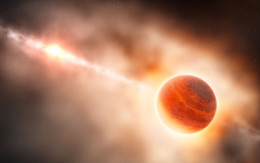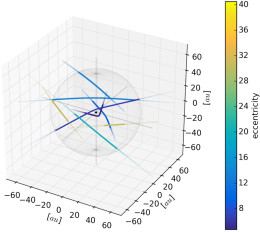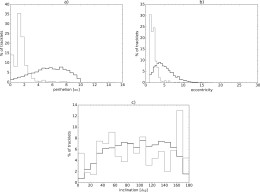How many comets, asteroids, and planetary bodies are floating through interstellar space, not gravitationally bound to any solar system? A new study explores this question and what its answer means for our understanding of how solar systems form.
Rough Beginnings

Do all solar systems form with gas-giant migration causing a large fraction of the system’s material to be ejected? [ESO/L. Calçada]
If this model is correct, and if other solar systems formed in the same way, then it stands to reason that interstellar space should be littered with free-floating, rogue planets, asteroids, and comets. So why have we never yet observed a sizable interstellar object? Do these non-detections mean that our models are wrong? Or just that our ability to spot interstellar objects isn’t good enough yet?

Trajectories of eight synthetic interstellar objects modeled by the authors as they pass within 50 AU of the Sun. [Engelhardt et al. 2017]
Predicting Detections
To answer these questions, a team of scientists led by Toni Engelhardt (University of Hawaii’s Institute for Astronomy and Technical University of Munich, Germany) and Robert Jedicke (University of Hawaii’s Institute for Astronomy) set out to find an observational upper limit on the spatial number density of interstellar objects using data from three different contemporary wide-field solar system surveys.
The team first simulated a synthetic population of interstellar objects out to a distance of 750 AU from the Sun. The authors then propagated the positions of this population forward in time to account for the effects of our Sun’s gravitational pull on passing objects, known as “gravitational focusing”.
Using the resulting distribution of interstellar objects within 50 AU of the Sun, the authors then simulated the detection of these objects with three surveys: Pan-STARRS1, the Mt. Lemmon Survey, and the Catalina Sky Survey.
The authors calculate the number of interstellar objects in their synthetic population that the surveys should have been able to detect in their 19 cumulative survey years. From the surveys’ non-detections, they then estimate an upper limit to the number density of interstellar objects in the solar neighborhood.
Not Many Interstellar Objects

Orbital elements for the synthetic interstellar objects that the authors find Pan-STARRS1 should be able to detect. Black lines denote active comets and grey lines denote inactive asteroids. [Engelhardt et al. 2017]
What does this mean? This is a stricter upper limit than the number densities predicted by many currently accepted solar system formation models. There are two explanations for this that the authors deem most likely:
- The properties we expect for interstellar objects based on what we observe in our own solar system — in particular, the distribution of their sizes — are wrong.
- Other solar systems didn’t form like ours did, ejecting the vast majority of its protoplanetary material into interstellar space.
While this remains an unsatisfying conclusion, observations from powerful future sky surveys like the Large Synoptic Survey Telescope (LSST) may help us to further home in on the answer to this puzzle.
Citation
Toni Engelhardt et al 2017 AJ 153 133. doi:10.3847/1538-3881/aa5c8a


4 Comments
Pingback: Contando asteroides y cometas rebeldes – Observatori Astronòmic
Pingback: Abril 2017 – Observatori Astronòmic
Pingback: Contando asteroides y cometas rebeldes « SEDA / LIADA - RedLIADA - Cursos LIADA - Cielo del Mes - Fenómenos Astronómicos - RELEA
Pingback: Contando asteroides y cometas rebeldes | Web de la Sección de Asteroides de la LIADA – Liga Iberoamericana de Astronomía.